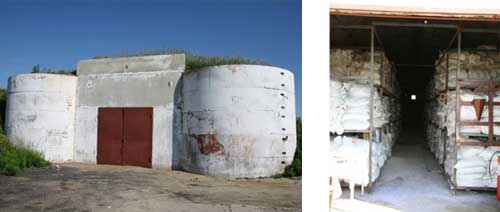International Programs
Proper Storage of Contaminants in the Russian Arctic
The Arctic is fragile, and is an early warning indicator of the state of the larger planet. Almost all Russian rivers flow to the north, where contaminants accumulate in seaweed, fish, birds, and mammals. Through the subsistence food chain, these contaminants quickly find their way into the bodies of indigenous people where they stay for years. Native Americans in the Arctic, who neither produced nor used these chemicals, are at risk.
Since 2004, EPA has represented the U.S. in the Arctic Contaminants Action Program ![]() (ACAP), which includes the U.S., Canada, Denmark, Finland, Iceland, Norway, Sweden, and Russia. Working together with our partners, EPA is helping to greatly reduce environmental contamination in the Arctic. Under EPA leadership, ACAP has coordinated work to inventory, analyze and provide safe storage for over 4,000 metric tons of obsolete and prohibited pesticides in the Arctic and sub-Arctic regions of Russia. Prior to this project, the contaminants were released directly into those northward-flowing Russian rivers and transported to the Arctic.
(ACAP), which includes the U.S., Canada, Denmark, Finland, Iceland, Norway, Sweden, and Russia. Working together with our partners, EPA is helping to greatly reduce environmental contamination in the Arctic. Under EPA leadership, ACAP has coordinated work to inventory, analyze and provide safe storage for over 4,000 metric tons of obsolete and prohibited pesticides in the Arctic and sub-Arctic regions of Russia. Prior to this project, the contaminants were released directly into those northward-flowing Russian rivers and transported to the Arctic.
Thanks to the pesticides management program we initiated, Russian regions are now contributing their funds and manpower in development of creative solutions to pesticides storage. For example, they have converted an abandoned missile silo in Altai Krai, Southern Siberia, into an effective storage facility for legacy pesticides.
Under the Arctic Contaminants Action Program, EPA is addressing management of priority pollutants under the Stockholm convention, reducing of mercury contamination and implementing cleaner production training.
EPA, together with Russia, developed and implemented a model Cleaner Production Program at one of the world’s largest emitters of air pollutants, Norilsk Nickel Company, located in the Russian Arctic. This ACAP project included economic incentives to achieve environmental gains and has resulted in a savings of over $9 million USD to the company, and measurable environmental reductions including:
- Reduced fresh water consumption: 7.9 million cubic meters
- Reduced waste discharge: 3.4 million cubic meters
- Reduced electrical energy use: 14.9 million kWh
- Reduced diesel oil use: 210 tons
- Reduced discharge of heavy metals and their oxides into the atmosphere: 850 tons
Two EPA Cleaner Production Projects have been awarded the highest Russian Environmental Award - - the “Vernadsky” Award by the Russian “Duma.”

The pictures above show a Pokrovka former missile hangar, which was dismantled under the US Cooperative Threat Reduction Program. In 2007 it became an interim storage site for obsolete and prohibited pesticides under the ACAP Project.
